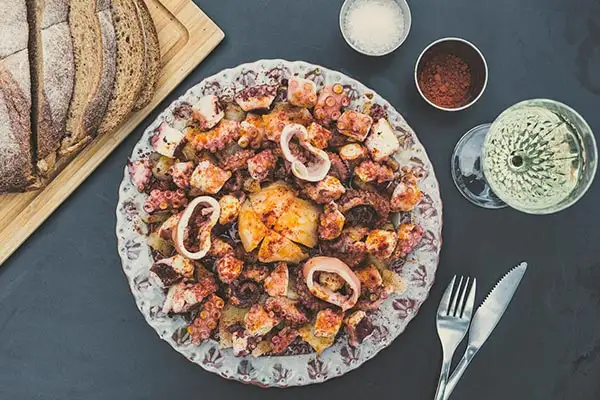By Cila Warncke
Galicians (galegos in their native tongue) call their homeland ‘terra de meigas’—land of witches. With its thick fogs, vine-tangled forests, ancient stone buildings, and howling Atlantic gales, it’s easy to see why many are ready to attribute supernatural powers to the north-west corner of Spain. My first reaction to the countryside on a sunny spring day was, “this is magic land.”
Retire in Galicia

Should you retire to Galicia, you’ll be in good company with the many natives who spent their working lives abroad. We found them generous, welcoming, and delighted that somebody had made the effort to seek out their corner of Spain. That said, there is a difference between being treated kindly as neighbors and becoming a friend. Even Spaniards from other parts of Spain remark on how hard it is to crack the acquaintance level. If you have an interest in local history, agriculture or gastronomy, though, you will find a welcome. I love Galician wine and met wonderful people in the course of visiting vineyards, shops, and bars.
The three main cities, Santiago, A Coruna, and Vigo, are well-served by internal and European flights. Santiago is the destination of the Camino de Santiago. Legend holds that the body of James the Apostle (Saint James hence Santiago) was carried from the Holy Land to Galicia in a boat guided by an angel. Several hundred years later a shepherd found his body. A cathedral was commissioned to house the saint and word conveyed to the faithful, kick-starting a millennium-long boost to the local economy. In addition to welcoming hordes of blistered North Americans with oversized rucksacks, Santiago (with a population of 98,000) is an ancient, charming university town. Vigo (with a population of 300,000), on the south-west coast of Galicia, is a lively port. A Coruña (population 250,000) is a cozy, middle-class city that was home to a youthful Pablo Picasso. Inland lies Lugo, which is surrounded by the world’s only intact Roman wall; another Roman outpost was Ourense—the spas they built at its geothermal springs are still open to the public. Ourense is also a jumping-off point for the Ribeira Sacra, a spectacular wine-growing region.
Get Your Free Spain Report Today!
Get Your Free Spain Report Today!
Learn more about the lower cost of living in Spain and other countries in our free daily postcard e-letter. Simply enter your email address below and we'll also send you a FREE REPORT — Live the Good Life in Sunny, Affordable Spain.

By submitting your email address, you will receive a free subscription to IL Postcards, Overseas Dream Home, The Untourist Daily and special offers from International Living and our affiliates. You can unsubscribe at any time, and we encourage you to read more about our Privacy Policy.
Lifestyle in Galicia

When my husband and I moved to a village near A Coruña, I joked to friends that “it’s Spain for people who don’t like Spain.” This is only fractionally true. Galicia is so unlike what most expats think of as Spain that it could be a different country. Those in search of paella, flamenco, Moorish architecture, olive trees, or sizzling sunshine should look elsewhere.
Galicia is Celtic, not Latin (though the Romans spent plenty of time there). Galicians tend to be fair; fiery hair and blue eyes are common. Its traditional instrument is the bagpipe; its folk dances wouldn’t be out of place in Galway, Ireland; its coastline is wild and unspoiled. Even its language, which has its roots in Portuguese, distinguishes it from the rest of the peninsula.
Another notable difference: Galicia is one of the few regions of Spain shaped by migration. During the late 19th and throughout the 20th-century hundreds of thousands of Galegos immigrated to South America, Cuba, the U.S., and other European countries. Many of those who could returned to build homes and live out their final years here. This may explain the rather grand houses dotting the countryside, too grand, I suspect, to have been built on local wages. Low pay and a challenging employment market are persistent problems; Galicia, like other parts of Spain, is suffering a long, slow erosion of rural life that has left hundreds of abandoned villages.
Abroad or at home, Galicians are ingenious, hard-working, and tough. Our neighbors were farmers, none of them under 65. Jogging, I’d spot them—men in jumpsuits, women in shapeless old dresses, all in wellies—herding cows, planting potatoes, or hacking kale stalks with a machete. Everyone outside of the city seems to have a patch of corn and kale. Plants grow at triffid velocity in the wet, temperate climate. The local produce is sublime and criminally inexpensive.
Food is a point of pride. The icy Atlantic yields world-class shellfish including fist-sized mussels, clams razor clams, and goose-neck barnacles; once eaten the eponymous octopus dish, pulpo galego, will discourage you from any other. These delicacies are best enjoyed overlooking the sea so don’t be fooled by unprepossessing village restaurants; the rustic ambiance is a mere front for gourmet food. Also unmissable is the Galician tortilla de patata. Betanzos, a small town about 30 minutes from A Coruna, hosts an annual tortilla festival; any time of year, though, it’s worth a visit to taste the magic local chefs conjure with eggs, potatoes, and olive oil. Galicia is Spain’s outstanding beef and dairy producer, too. The indigenous vaca galega are tawny, gentle beasts whose cheese, milk, and meat have been awarded ‘protected designation of origin’ (IGP) status by the European Union.
We understood the regional preoccupation with food better as the summer high temperatures of 70 F to 73 F yielded to a steady 46 F to 53 F, day and night, from October and April. On paper, that doesn’t look bad but weeks without sun drive damp and chill into every joist and joint. There were entire weeks where we were in a cloud, not under it, thick swathes of sodden air erasing the trees that hemmed our property. On days like that, a hot, hearty meal accompanied by a few glasses of the local Mencia red wine, seemed more necessity than an indulgence.
Cost of Living in Galicia

Property averages $1,600 per square meter to buy (versus $3,400 in Madrid and $3,220 in Barcelona); to rent it is $8.50 per square meter (again, about half Madrid or Barcelona’s average). A modest two-bedroom, two-bathroom apartment in A Coruña costs around $240,000; in Lugo, around $150,000; in Vigo circa $300,000.
Outside the cities, single-family homes are common (another rarity in Spain). These can be bargains. The house we rented, for example, was a three-bedroom, four-bathroom 300 square meters renovated farmhouse with 8,000 square meters of land. It was on sale for $230,000. A few things to keep in mind if you go the country route: 1) internet availability, speed, and reliability; 2) maintenance costs including garden, septic tank, mold prevention, etc.; 3) heating options and costs. If you buy an older house, budgeting for new insulation may be wise.
You can eat, drink and be merry for almost nothing, though. A bottle of excellent wine costs $7 to $9.50, a tortilla de patatas will feed three for $17 and you can sink your teeth into exquisite seafood for $12 to $18 for a main.
Below is a sample budget for a couple living in Galicia:
| Expenses | U.S. $ |
|---|---|
| Rent | $720 |
| Electricity | $120 |
| Gas (heating/stove) | $70 |
| Groceries | $420 |
| Cell plan | $35 |
| Internet | $60 |
| Car (maintenance/fuel) | $150 |
| Health insurance | $180 |
| Dining out | $300 |
| Total | $2,055 |
Things to Do in Galicia
Cila Warncke

Galicia reveals a lesser-known, romantic side of Spain. Its rolling tree-clad hills, vibrant green pastures dotted with fawn-colored cows, and frisky sheep, wind-scoured white-sand beaches, and weather-beaten stone villages will feel familiar to anyone who has visited the west coasts of Scotland or Ireland. The resemblance is more than casual; they share Celtic heritage, Roman influence, and histories shaped by migration.
One critical difference is Galicia is 10-plus degrees of latitude south. Frequent, abundant rain is offset by strong sunshine, making waterproofs and sun-cream equally important. The variable weather is a pleasant justification for alternating active days with those devoted to long lunches, and a bottle of wine, accompanied by a good book or conversation. Galicia is renowned for its literary culture. The ‘day of Galician letters’ is a public holiday and locals browse newspapers at the bar, rather than smartphones.
City Sight-Seeing

There are a handful of must-see cities in Galicia, each with a distinctive local character and historical claim. The capital of the community, Santiago de Compostela, is famed as the destination of the Camino de Santiago. Once you get past the back-packer traffic around the Cathedral there is a wealth of narrow streets lined with small shops and restaurants. The central market is also a fantastic place to eat and people watch.
Lesser-known, and better for it, are Ourense and Lugo. The latter is a small, hard-working city whose old town is surrounded by the world’s only remaining intact Roman wall. Far from a museum piece, the wall is as wide as a country road; walking its circuit offers a delightful view of city life. Within its embrace lie a cathedral, provincial museum, and Domus Oceani which houses Roman mosaics. About 90 minutes due south is Ourense whose Roman heritage is preserved in the bubbling water of its natural hot springs (termas). There are private spas but you can still take a dip in one of the free municipal termas, as locals have done for the last 2,000 years. Ourense is also the ideal jumping-off spot for a visit to the Ribeira Sacra wine region. There, vineyards clinging to 45-degree slopes produce vibrant red wines from the native Mencia grape, Spain’s answer to Pinot Noir. Group or bespoke tours with Northwest Iberia Wine ensure you don’t miss any hidden gems.
From Ourense, it’s an hour or so drive through Rias Baixes wine country (home of the distinctive white grape Albariño) to Galicia’s largest city, the port of Vigo. With steep hills tumbling to the sea and rows of bright houses strung above the harbor, it could easily be a slice of Scandinavia. In the region, Vigo is known for its all-out Christmas. It blows a generous portion of the municipal budget on lighting the streets like a circus, which provides a glittering backdrop to the stalls and entertainments of its holiday fair.
Two more coastal cities complete the tour of Galicia’s urban attractions, Pontevedra, 30 minutes north of Vigo is a pedestrianized city whose attractions include 13th-century convent and church allegedly founded by Saint Francis and an impressive Gothic cathedral. Another 90 minutes on the road takes you to A Coruña, a handsome, bourgeois city that Pablo Picasso called home, as a boy. The airy flat the artist’s family occupied while his father taught art at a nearby school is a simple, elegant oasis from the surrounding downtown bustle. Other landmarks are the Torre de Hercules (Tower of Hercules) the world’s oldest operational Roman lighthouse. The Torre dominates an undulating headland covered in gorse and heather, reinforcing the suspicion one has fallen into a Celtic parallel universe.
Food and Drink

For all their diversity, Galicia’s settlements have one thing in common: superb food at embarrassingly modest prices. A platter of melt-in-the-mouth fresh octopus, the famed pulpo gallego, will set you back about $12.50 in a seaside bar; slabs of fresh tuna or cod, the same. Shellfish are a point of pride: fearless gallegos wrestle mussels, clams, razor clams, and the rare, prized goose-neck barnacle from the churning, ice-cold Atlantic. A friend and I once watched waves toss a fishing boat like a kid with a tennis ball: up, down, up, down. The seafood is definitely underpriced.
Lush pasturage has made Galicia the steak and dairy capital of Spain, meat from the indigenous cattle vaca gallega is protected by European law as a regional specialty, along with a semi-cured cow’s milk cheese tetilla gallega (it looks like a Madonna costume circa 1990, hence the name). Another thing you might note is that bars tend to serve crisps, not olives. This is prime potato country and the Bonilla a la Vista brand, which hails from the Inditex fast-fashion empire’s hometown of Arteixo, are possibly the best crisps you’ll ever eat.
Potatoes are central to another classic that Galicia does better than anywhere: tortilla de patata. The frittata-like dish is ubiquitous across Spain but the Gallegos perfected it. They eschew onions, relying on the orange-juice-hued yolks of local farm eggs for flavor. With nothing more than a few potatoes, oil, salt, and a hot skillet a skilled tortilla chef can make a masterpiece.
Unmissable Events

Festival Noroeste
Gallegos are loyal to Estrella Galicia and the brewery returns the favor. Each August it sponsors a series of free concerts on the beach in the center of A Coruña. That time of year it is just about warm enough to enjoy the open air and there is no ‘open container’ nonsense. Waterfront restaurants gear up for takeaway and everyone piles onto the sand with food, booze, babies in pushchairs, and bonhomie.
More information online here: Festival Noroeste
Semana de la Tortilla
The epicenter of tortilla perfection is the unprepossessing town of Betanzos, about 30 minutes inland from A Coruña. For a week each October, every restaurant in town turns its attention to egg-and-potato perfection. Visitors get cards and tick off eateries as they compare tortilla styles and give the Estrella Galicia beer pumps a workout.
More information online here: Semana de la Tortilla
Fiesta del Marisco
Seafood lovers should mark their calendar for the annual October Seafood Festival in O Grove, about an hour north of Vigo. From a humble start in the 1960s it now attracts some 200,000 gourmands – enough to make it buzzy but not enough to lose its air of exclusivity. Feast on mussels, clams, barnacles, cockles, lobsters, and of course octopus, perfectly paired with crisp albarino.
More information online here: Fiesta del Marisco
Arde Lucus Roman Festival
Experience life within Lugo’s Roman walls as it might have been lived when it was Lucus Augusti – assuming Romans spent a lot of time wandering around guzzling paper cups of beer. Held in June, the festival features circuses, military camps, dancing, artisans, Roman weddings, gladiators, and plenty of spontaneous drama.
More information online here: Arde Lucus
Featured Image Copyright: ©iStock.com/Lux Blue
Get Your Free Spain Report Today!
Get Your Free Spain Report Today!
Learn more about the lower cost of living in Spain and other countries in our free daily postcard e-letter. Simply enter your email address below and we'll also send you a FREE REPORT — Live the Good Life in Sunny, Affordable Spain.

By submitting your email address, you will receive a free subscription to IL Postcards, Overseas Dream Home, The Untourist Daily and special offers from International Living and our affiliates. You can unsubscribe at any time, and we encourage you to read more about our Privacy Policy.















